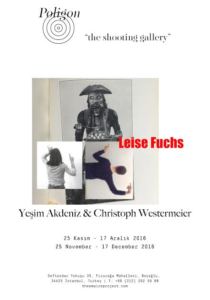Leise Fuchs

The Shooting Gallery, 11/25/2016 - 12/17/2016
Defterdar Ykş. No:35, Firuzağa, 34425 Beyoğlu/İstanbul, Turkey
Using the hand sign “Leise Fuchs”, German primary school teachers raise their right arm with the forefinger and little finger pointing upwards while the middle and ring finger point towards the thumb, a symbol for a closed mouth and open ears, to quiet the students and maintain order in the classroom. Pupils respond to the teacher by repeating the same gesture, which looked like a fox ( Leise Fuchs* quiet fox). After a whole generation of students had been raised using this sign, German teachers realized that “Leise Fuchs” is also the sign of Bozkurtlar of Turkey (Bozkurtlar* a turkish nationalist group). For Bozkurtlar the same sign symbolizes a wolf rather than a fox. Looking for a new sign, teachers started raising the right arm and pointing to their mouth with the left forefinger. When pupils showed the new sign to their parents, they were horrified by its similarity to the Nazi salute. This instigated a public debate about signs and their meanings.
Even though they both studied at the Kunstakademie Dusseldorf and De Ateliers Amsterdam, lived in Germany and Turkey at various times, and have researched 'Orientalism' for previous works, 'Leise Fuchs' is the first collaborative show by artists Yesim Akdeniz (lstanbul) and Christoph Westermeier (Düsseldorf). In this site-specific installation, as the artists question the notion of ‘Silence’ in society, they playfully narrate issues related to the mechanism of staying silent or being silenced, of covering or veiling the uncomfortable and unfitting. At the same time, by naming the exhibition after a sign that stands for silence as well as for violent nationalism, the two artists concentrate on the generalization of stereotypes as well as the question of authorship.
After 17th century military operations by the Ottoman Empire in Europe ceased, Turquerie, a trend that impacted architecture, dance, music, fashion and art, became fashionable as western aristocracy started to view the Ottoman Empire as a mysterious place with unknown treasures. Various publications and prints of iconic oriental paintings created an image that still defines the look of orientalism. The collection of Turquerie paintings in the Vurberk gallery, now at the castle of Ptuj, Slovenia, is an outstanding example of this trend. For Akdeniz and Westermeier this collection of 47 paintings , showing Ottoman nobleman, pashas, dignitaries and their families, played a key role in the discussion of ''Leise Fuchs''. From a western perspective, anything east of Europe is viewed as oriental, thus the collection also contains case studies about different cultures associated with orientalism such as Greek, Jewish, Persian, Oriental, African, Indian, Chinese men and women.
The exhibition 'Leise Fuchs' flirts with the ironic fact that paintings in this collection were painted by at least ten different painters. Clichés and stereotypes used had different meanings depending on the relative cultural background of the artist. Yesim Akdeniz and Christoph Westermeier made new works for the 'Leise Fuchs' exhibition that point out some of the misunderstandings and fascinations of other cultures.
For More Information